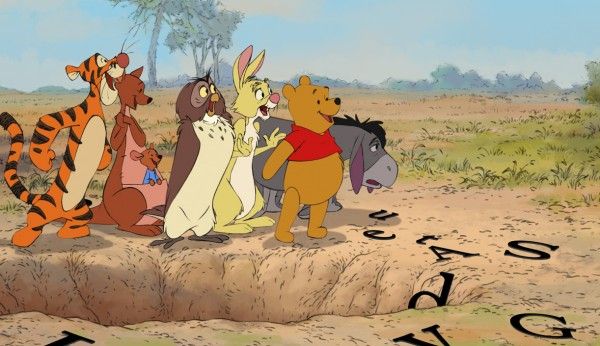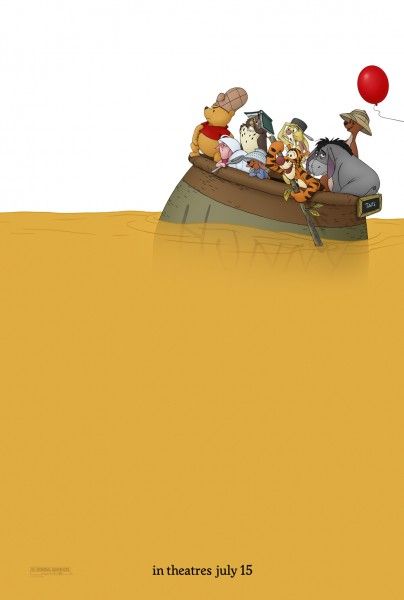Inspired by the stories from A.A. Milne’s books, and in Disney’s classic, hand-drawn art style, the beloved characters in the world of Winnie the Pooh are back on the big screen after 35 years. As lovable and charming as ever, Pooh wakes up hungry and out of honey, setting him out on a journey to stop the rumbling in his tummy. Along the way, he learns that Eeyore has lost his tail and, after misinterpreting a note, believes Christopher Robin to have been captured by a creature in the Hundred Acre Wood. Over the course of one very busy day, Pooh, Tigger, Rabbit, Piglet, Owl, Kanga and Roo, all work together to save Christopher Robin from the imaginary culprit, and find something for the always gloomy Eeyore to use as a tail.
At the film’s press day, co-directors Don Hall and Stephen Anderson talked about bringing such well-loved characters back to life on the big screen, how much they enjoyed working in 2D hand-drawn animation, what Zooey Deschanel’s musical contribution adds to the film, and bringing humor to these classic characters. Check out what they had to say after the jump
Question: Would you ever have thought you’d direct a Winnie the Pooh movie one day?
STEPHEN ANDERSON: No. I would have told you that you were crazy, if you told me that a few years ago. I think the idea of Winnie the Pooh coming back into the building was something we wouldn’t have anticipated. But, once (executive producer) John [Lasseter] sat down with us and said, “Hey, here’s an idea I’d like you guys to consider,” suddenly it was a really exciting proposition because these characters are so beloved, they’re so well-defined, and they’re just fun to work with. They’re fun to draw, they’re fun to write for, and they’re fun to work with the animators to bring them to life. It became a real joy.
What was it like to get to work with 2D animation for this?
DON HALL: It was a blast. We basically inherited the Princess and the Frog crew. They had just come off of that. I had worked with them a little bit ‘cause I was head of story on that. Not in the same capacity, obviously, but we all worked together on that film. We saw what they could do on that film, and they’re the masters of animation. It was like a dream team. Having all these wonderful animators felt like whoever coached the Dream Team all those years ago, with all those great basketball players, and having them so excited to put their stamp on these character. They were so into it. It was a joy to work with them.
ANDERSON: Because these characters were born in the pages of a children’s book, their roots are in drawing, in two dimensions. And then, Disney brought them to the screen in hand-drawn animation, back in the ‘60s. It’s the perfect thing to get to be continuing the hand-drawn animation legacy with today because you want them to live in that kind of simple, loosely drawn, two-dimensional world. It’s perfect for these characters. It’s really the way that we want to see them, and we believe the rest of the world wants to see them as well.
How did you go about creating Hundred Acre Wood?
HALL: Well, we were lucky enough to actually go there (to Ashdown Forest in East Sussex, England). We suggested that idea, almost as a joke ‘cause we didn’t think they’d actually send us. We flew it up the flagpole just to see what would happen, and they said, “Sure, we’ll send you to England,” and we got to take our head of layout and our head of backgrounds. We spent three days there, doing watercolors and sketching and taking pictures, and the mission became trying to get that real place reflected in the movie. There’s a soft English light that all those English watercolors reflect, and we really wanted to get that in the film, in addition to just the actual foliage and stuff like that. We could easily just gone to the ARL (Animation Research Library) and grabbed backgrounds and reused them, but we didn’t want to do that. We wanted to make this as original as possible.
To what extent do you think Zooey Deschanel’s musical contribution compliments the narrative?
HALL: Well, we brought her in just to do the original Winnie the Pooh theme song because we wanted to get somebody contemporary to record it, but the list of appropriate artists is a pretty small list. When they showed us the list with her name on it, we felt like that was perfect. She is contemporary, she’s hip and cool, and she’s kind of trendy, but her sound is not at all contemporary. It’s a throwback. Her favorite artists are artists from the early ‘60s, and her sound reflects that, so we felt like she was the perfect choice for that Winnie the Pooh theme song. And, when she came in to do that, she was so enthusiastic about the project and so cool to work with, and we loved what she did with that song, we just kept trying to find more things for her to do. Essentially, she became our musical narrator. She sang “A Very Important Thing To Do” at the beginning of the film, and then she wrote and sang the beautiful end credits song too. Like John Cleese is our narrator in the film, she became our musical narrator. It just worked out that way. It wasn’t pre-ordained. It just happened.
Since there are two of you, how do you divide the labor on a project like this?
ANDERSON: In a weird way, we didn’t. I know a lot of directing teams do that and say, “You take these sequences, and I’ll take those sequences. You deal with animation and layout, and I’ll deal with this.” We worked together from the very beginning. We’ve both been here, more or less, the same amount of time, so we’ve worked together on so many projects that we just have a good working relationship. So, when we started, we didn’t feel like we needed to divide it up. In fact, I think it was better for us to be in the room together so we had that back-and-forth, as opposed to doing it individually, and then coming back together and having to have that step and process. You’re adding another step that you don’t really need. If we can just be in the room together, in the moment, we can come to our consensus then, and everybody knows what direction to go in. It worked really great for us just to be together, the whole way.
What was it like to take on these classic characters? Was there any pressure in that?
HALL: At the beginning, there was a little pressure. It dawns on you when they tell you that Pooh is the second most popular character in the world, aside from Mickey Mouse. But, we were pretty diligent with our preparation and research. We watched those films from the ‘60s, but we also read the Milne text and got very familiar with it, and so did our story team, so that we could all write with that in mind. We didn’t really have a script on this film. We wrote and storyboarded it at the same time, which is an odd, old school move, but it worked. We were all in the room, at the same time, creating it and we all were able to channel Milne’s voice. Also, the research trip, going to the real Hundred Acre Wood helped us to feel pretty prepared, by the time we actually started to make the film. We’d done our homework and we’d done our research. Once we had all those pieces in place, we were pretty comfortable that we would do it justice.
ANDERSON: In terms of what we felt we could change or not change, we really didn’t feel like we wanted to change much of anything because we loved what had been done. It was really less about changing and more about expanding it and pushing the characters and humor just a little bit further than ever. We wanted to just advance Winnie the Pooh a little bit, into today’s world, and not break it, but just push it a bit. We never wanted to go too far, where people would say, “Pooh would never do that,” or “That’s much too contemporary of an idea.”
HALL: That happened with every production step, along the way.
What do you feel you added that made it your own?
ANDERSON: The humor. If anything, I think the team’s stamp on it is that it’s funny. The classic shorts were funny as well, but we hope that this movie is funnier than that. We’re still retaining the heart and the charm that you want in Winnie the Pooh, but really exploring and embracing the humor that Milne created and that the original team created. That’s just inherent in these characters because of their innocence and all of their comic viewpoints. Because of those, they have so much entertainment potential, so we didn’t want to leave any stone unturned, as far as humor. That’s what we brought to this legacy.
HALL: Early on, once we were asked to make it a feature, we knew that that was our best bullet. At the time, we didn’t know we’d be coming out in the summer against Harry Potter, but we did know that this isn’t a comic book movie with a villain and a villain’s plot and dramatic tension and character arcs. We looked at our strengths and weaknesses and decided to take that strength, which is humor, and mine it for all we could.
When was the decision made to have the characters interact with the text?
ANDERSON: Right at the very beginning. That was on our list of those iconic elements from the classic shorts that we knew had to be in the film. There was the live-action opening, the narrator interacting with the characters, the characters playing with the text of the pages on screen, the music being part of it. Early on, we just said, “We don’t know what the movie is going to be or what the story is, we just know that, whatever we do, we have to have these elements.” They’re elements that made those shorts, from the ‘60s and early ‘70s, unique to anything else the studio had done. They really had never broken the fourth wall, to that extent, or always reminded the viewer that what they’re watching is a storybook come to life and the illustrations on the page are actually the movie you’re watching. That was really clever and really unique. We wanted to make sure that our film would sit on a shelf next to those films and feel of a piece.
HALL: All of those things were really inventive for the time, and actually they’re even inventive now. A lot of films don’t do that. In a sense, it breaks filmic rules to break the fourth wall like that, and even breaking the reality of the film, so that they can walk out of a scene. All of that stuff is very specific to Winnie the Pooh, we felt, and we really wanted to maintain that.



